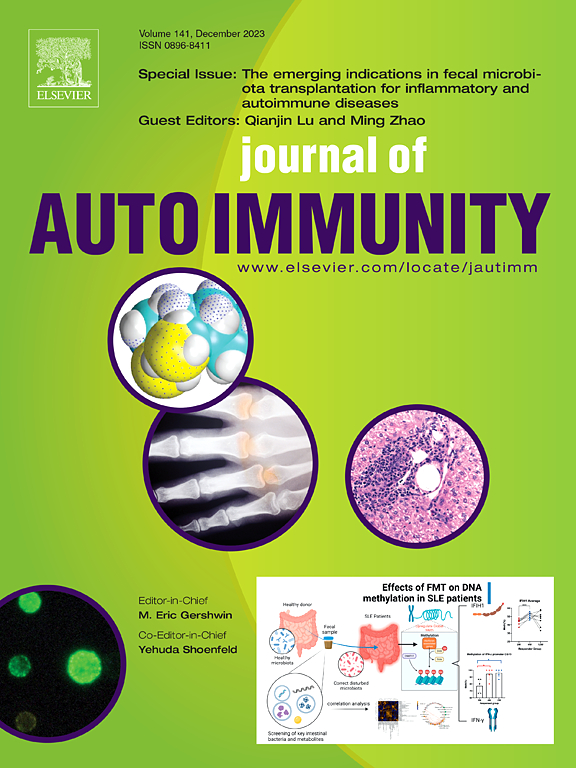自身免疫性疾病与胰高血糖素样肽-1受体激动剂之间的关系:一项真实世界的证据研究
IF 7
1区 医学
Q1 IMMUNOLOGY
引用次数: 0
摘要
胰高血糖素样肽-1受体激动剂(GLP-1 RAs)在糖尿病治疗中的优势已被证实。然而,它们与自身免疫性疾病的潜在关联尚不清楚。使用全面的真实世界数据集,本研究比较了GLP-1 RAs与二肽基肽酶-4抑制剂(DPP-4is)在自身免疫性疾病发病率方面的差异。方法采用主动比较者和新用户设计的回顾性队列研究,分析来自TriNetX美国协作网络的数据。从2015年1月1日至2022年12月31日,我们确定了4,841,560名年龄在18岁以上的2型糖尿病患者。最终,GLP-1 RAs组和DPP-4is组分别纳入412,021例和383,415例患者。使用倾向评分匹配来平衡基线特征,并使用Cox回归模型估计八年随访期间的风险比(hr)。结果经倾向评分匹配后,每组纳入290,770例患者。分析显示,接受GLP-1 RAs治疗的患者出现某些自身免疫性疾病的风险显著增加,包括溃疡性结肠炎(HR, 1.11;95% CI, 1.04-1.19),类风湿关节炎(HR, 1.08;95% CI, 1.03-1.12),自身免疫性甲状腺炎(HR, 1.30;95% CI, 1.24-1.38),强直性脊柱炎(HR, 1.30;95% CI, 1.13-1.51)和牛皮癣(HR, 1.17;95% CI, 1.12-1.22),与DPP-4is组比较。此外,敏感性分析一致显示GLP-1 RAs使用与自身免疫性疾病之间存在显著联系。结论:本研究提示,与dpp -4相比,GLP-1 RAs的使用与某些自身免疫性疾病的风险增加有关。使用GLP-1 RAs的患者可能需要仔细监测。本文章由计算机程序翻译,如有差异,请以英文原文为准。

Association between autoimmune diseases and glucagon-like peptide-1 receptor agonists: A real-world evidence study
Introduction
The therapeutic advantages of glucagon-like peptide-1 receptor agonists (GLP-1 RAs) in diabetes management have been demonstrated. However, their potential association with autoimmune diseases remains unknown. Using a comprehensive real-world dataset, this study compared GLP-1 RAs against dipeptidyl peptidase-4 inhibitors (DPP-4is) with respect to the incidence of autoimmune diseases.
Methods
This retrospective cohort study, with an active-comparator and new-user design, analyzed data from the TriNetX US Collaborative Network. We identified 4,841,560 patients aged over 18 years with type 2 diabetes from 1 January 2015 to 31 December 2022. Finally, 412,021 and 383,415 patients were included in the GLP-1 RAs and DPP-4is groups, respectively. Propensity score matching was used to balance baseline characteristics, and hazard ratios (HRs) were estimated with Cox regression models over an eight-year follow-up.
Results
After propensity score matching, each group included 290,770 patients. The analysis revealed that patients receiving GLP-1 RAs exhibited significantly higher risks of certain autoimmune conditions, including ulcerative colitis (HR, 1.11; 95 % CI, 1.04–1.19), rheumatoid arthritis (HR, 1.08; 95 % CI, 1.03–1.12), autoimmune thyroiditis (HR, 1.30; 95 % CI, 1.24–1.38), ankylosing spondylitis (HR, 1.30; 95 % CI, 1.13–1.51), and psoriasis (HR, 1.17; 95 % CI, 1.12–1.22), compared to those on DPP-4is. Moreover, sensitivity analyses consistently revealed a significant link between GLP-1 RAs use and autoimmune diseases.
Conclusions
This study suggests that compared with DPP-4is, the use of GLP-1 RAs is linked to increased risks of certain autoimmune diseases. Careful monitoring might be required among patients on GLP-1 RAs.
求助全文
通过发布文献求助,成功后即可免费获取论文全文。
去求助
来源期刊

Journal of autoimmunity
医学-免疫学
CiteScore
27.90
自引率
1.60%
发文量
117
审稿时长
17 days
期刊介绍:
The Journal of Autoimmunity serves as the primary publication for research on various facets of autoimmunity. These include topics such as the mechanism of self-recognition, regulation of autoimmune responses, experimental autoimmune diseases, diagnostic tests for autoantibodies, as well as the epidemiology, pathophysiology, and treatment of autoimmune diseases. While the journal covers a wide range of subjects, it emphasizes papers exploring the genetic, molecular biology, and cellular aspects of the field.
The Journal of Translational Autoimmunity, on the other hand, is a subsidiary journal of the Journal of Autoimmunity. It focuses specifically on translating scientific discoveries in autoimmunity into clinical applications and practical solutions. By highlighting research that bridges the gap between basic science and clinical practice, the Journal of Translational Autoimmunity aims to advance the understanding and treatment of autoimmune diseases.
 求助内容:
求助内容: 应助结果提醒方式:
应助结果提醒方式:


